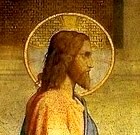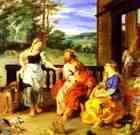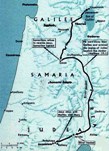Entry into Jerusalem
Jesus comes in triumph to Jerusalem
Questions for Bible study groups
- What was significant about the road Jesus took into Jerusalem?
- What was the significance of the colt that Jesus rode into Jerusalem?
- Why was this event so important? What did it say (a) about Jesus and (b) to the people in Jerusalem at the time?
Jesus entered Jerusalem a few days before his death. He was acclaimed by a great crowd of people, many of whom believed he was the long-awaited Messiah.
You can’t appreciate the terrible grief of those words that Jesus spoke on the cross ‘My God, my God, why have you forsaken me?’ unless you remember the joyful tumult of Jesus’ entry into Jerusalem just a few days before.
The first Palm Sunday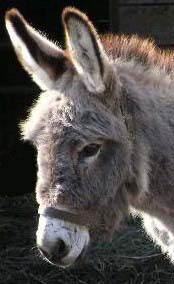
In the week before he died Jesus came to Jerusalem with his retinue of disciples. It was a dangerous move and would prove fatal, but he believed it was his destiny.
He approached the city from the east, from the Mount of Olives, where the Jewish people expected the Messiah to appear – and where the sun rises.
At Bethphage (the house of figs) he and his friends made a halt. It was just a small village, probably on the east side of the hill, not in a direct sight-line with Jerusalem. To put it in modern context, it was like an outer suburb of a large city. Nearby was Bethany, where Jesus often stayed with his friends Martha, Mary and Lazarus. He had been in the area recently when he resurrected Lazarus from the dead, and was well-known, a celebrity and an object of curiosity.
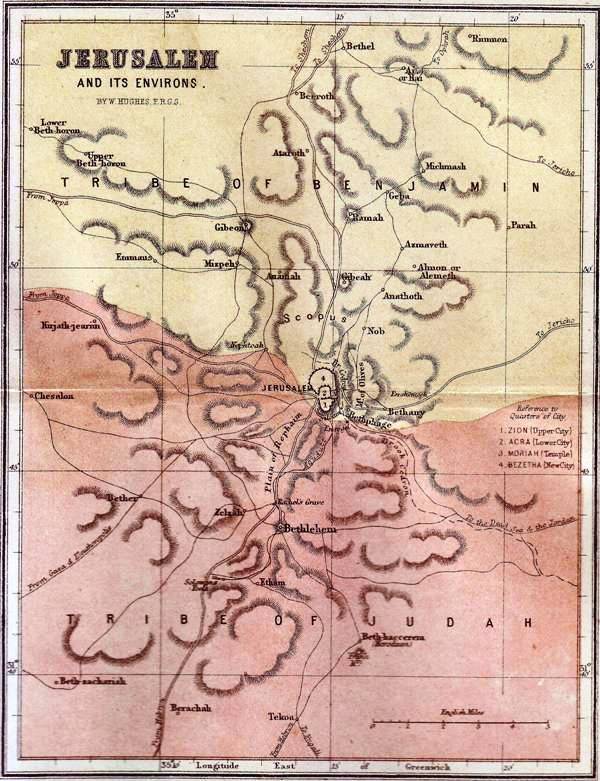
A map of Jerusalem and the surrounding towns and countryside. Bethany and Bethphage are east of Jerusalem on the southern end of the Mount of Olives, which runs roughly parallel to the city. The two hills/mounts are separated by the Kidron Valley. For more, see MAPS
Getting the colt
By the time Jesus reached Jerusalem he was travelling with quite a large group of people. He chose two of them and told them to go to Bethphage, and once there to look for a young donkey that had never been ridden. They were to bring it back to him. If anyone objected, they were say that Jesus of Nazareth needed it and would send it back immediately. No doubt that promise was later honoured.
On a surface reading this seems rather a high-handed thing to do, but Jesus probably had a previous arrangement with friends in the village, disciples whose names we will never know. He often stayed in Bethany, which was close to Bethphage, and may well have met people from this neighbouring village. Certainly they would have heard about him, and been impressed and curious.
The significance of the colt
For this part of the story, see the green text in the Gospel passages at the bottom of this page.
Once mounted on the colt, Jesus joined the throng of pilgrims walking and riding into Jerusalem. Down the hill, then up again through the city gates and up the winding streets to the Temple.
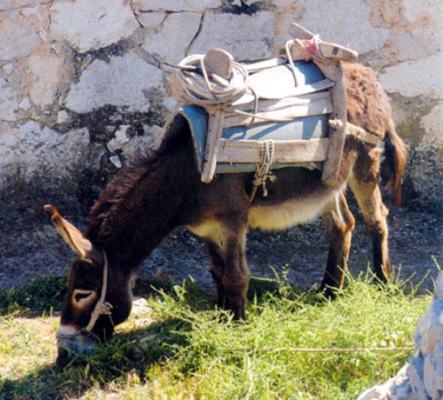
A donkey usually carried a wooden frame that could be used either as a saddle or a base for a load. In this gospel story the donkey is a colt, unused to the framework or to a rider. So the disciples threw their cloaks over its back to make a kind of informal saddle for Jesus.
Why did Jesus stage this event so carefully? Why not just walk beside his friends as he had been doing for years?
There was a prophecy that a king would come to Jerusalem, humble and riding a young donkey. Jesus wanted to signal to people that the words of the prophecy were actually coming true.
There was also a Roman tradition of a triumphal military procession – with horses, chariots, and soldiers. Everyone knew this. In stark contrast, Jesus deliberately entered Jerusalem on a peaceful, useful, humble little animal. The message was clear: though the Romans glorified war, Jesus stood for peace.
It seems a laudable idea, but in fact it was very dangerous. People who criticised the status quo, even if it was justified (perhaps especially so) seemed like rebels to the authorities, rather than prophets. They incited the people to change, which to the authorities meant destabilisation and possible rebellion. No wonder the Pharisees were nervous when they saw what Jesus was doing.
 Note: there is some confusion about the number of donkeys Jesus used. He is described as ‘mounted on an ass, and on a colt, the foal of an ass’: Obviously he could not have been riding two animals. The answer lies in the fact that Hebrew poetry often makes the second line repeat the first, but in different words – poetic repetition. John, using information from the other evangelists, takes it a step further by saying that Jesus had an ass and a colt.
Note: there is some confusion about the number of donkeys Jesus used. He is described as ‘mounted on an ass, and on a colt, the foal of an ass’: Obviously he could not have been riding two animals. The answer lies in the fact that Hebrew poetry often makes the second line repeat the first, but in different words – poetic repetition. John, using information from the other evangelists, takes it a step further by saying that Jesus had an ass and a colt.
Read the green text at end of page
And the crowd went wild…
As Jesus rode down the hill, the crowd swelled in numbers. Jesus’ disciples had cushioned the seat on the donkey with their cloaks, a thick padding of fabric, but the people went a step further. They lay their cloaks down on the ground so that the donkey walked over them, and spread branches of trees beneath the animal’s hooves. The practice of waving palms and branches held high in a procession was an act of honour for a revered leader, a way of welcoming him and signalling to the people around that something important was happening. Many people in the crowd may have expected that Jesus was about to lead some sort of political coup.
Read the red text at end of page
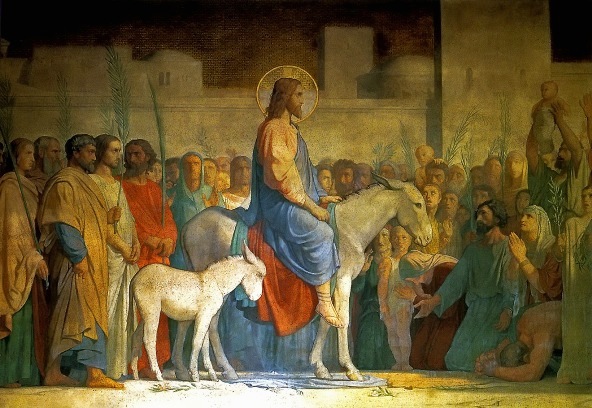
Christ’s Entry into Jerusalem, Hippolyte Flandrin, 1842
Welcome/entry into Jerusalem
The season of Passover attracted large crowds from all over the ancient world – as Mecca does today. On this particular day just before Passover, the road into Jerusalem was packed with pilgrims. Some of them knew about Jesus, some had never heard of him. But there was a holiday atmosphere. Hundreds of people? Thousands? Impossible to say. Most walked, but a number of them rode donkeys. It was a scene of organised confusion.
As they walked, the people chanted or sang a number of prayers, among them Psalm 118:25. It was traditionally sung by pilgrims as they walked the final leg of their journey up the hill towards Jerusalem, and contained the words ‘Hosanna to the son of David. Blessed is he who comes in the name of the Lord’. Luke says they sang ‘Peace in heaven’, perhaps because he was writing for Gentile readers who might not understand what ‘Hosanna’ meant.
They also shouted that Jesus was ‘King of Israel’, a very dangerous thing to say, especially in the context of a crowded, combustible Jerusalem.
Read the black text at end of page
Why was this event important?
There is far more to this event than meets the eye.
Previously, the centre of worship had been the Temple in Jerusalem. It was the central sacred place for the Jewish people. But in 1st century Palestine this supremacy was being challenged. Synagogues were springing up all over Israel – there was even a synagogue in unfashionable little Nazareth. These autonomous centres of worship were run by local men – educated and respected to be sure, but not of the official priestly class. So power had already started shifting away from Jerusalem, away from the blood sacrifice offered in the Temple.
John the Baptist and people like the Essenes were part of this process. They challenged the authority of Temple worship, moving the axis of power away from Jerusalem.
Jesus, and later the early Christians took it a step further. They developed the idea of a sacred person, a divine man. The focus of the sacred was no longer cantered on a fixed location, Jerusalem. The synagogues, and then Jesus, offered a powerful alternative to traditional Temple worship, and in so doing threatened the status quo.
The Temple priesthood were acutely aware of what was happening, and took steps to maintain their traditional power and authority. They would not let a peasant from rural Galilee upset centuries of religious tradition.
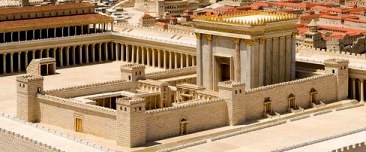
A model of the inner courts of the Temple of Jerusalem, built by King Herod
What happened next? See Jesus and the Money Changers
What the Gospels say
There are two descriptions of the birth of Jesus. Matthew focuses on Joseph, Luke on Mary.
1 Getting the colt: Read the blue text
2 Significance of the colt: Read the green text
3 Garments/palms/branches: Read the red text
4 Welcome/entry into Jerusalem: Read the black text
Mark 11:1-11
1 And when they drew near to Jerusalem, to Bethphage and Bethany, at the Mount of Olives, he sent two of his disciples,
2 and said to them, “Go into the village opposite you, and immediately as you enter it you will find a colt tied, on which no one has ever sat; untie it and bring it.
3 If any one says to you, ‘Why are you doing this?’ say, ‘The Lord has need of it and will send it back here immediately.'”
4 And they went away, and found a colt tied at the door out in the open street; and they untied it.
5 And those who stood there said to them, “What are you doing, untying the colt?”
6 And they told them what Jesus had said; and they let them go.
7 And they brought the colt to Jesus, and threw their garments on it; and he sat upon it.
8 And many spread their garments on the road, and others spread leafy branches which they had cut from the fields.
9 And those who went before and those who followed cried out, “Hosanna! Blessed is he who comes in the name of the Lord!
10 Blessed is the kingdom of our father David that is coming! Hosanna in the highest!”
11 And he entered Jerusalem, and went into the temple; and when he had looked round at everything, as it was already late, he went out to Bethany with the twelve.
Matthew 21:1-11
1 And when they drew near to Jerusalem and came to Bethphage, to the Mount of Olives, then Jesus sent two disciples,
2 saying to them, “Go into the village opposite you, and immediately you will find an ass tied, and a colt with her; untie them and bring them to me.
3 If any one says anything to you, you shall say, ‘The Lord has need of them,’ and he will send them immediately.”
4 This took place to fulfil what was spoken by the prophet, saying,
5 “Tell the daughter of Zion, Behold, your king is coming to you, humble, and mounted on an ass, and on a colt, the foal of an ass.”
6 The disciples went and did as Jesus had directed them;
7 they brought the ass and the colt, and put their garments on them, and he sat thereon.
8 Most of the crowd spread their garments on the road, and others cut branches from the trees and spread them on the road.
9 And the crowds that went before him and that followed him shouted, “Hosanna to the Son of David! Blessed is he who comes in the name of the Lord! Hosanna in the highest!”
10 And when he entered Jerusalem, all the city was stirred, saying, “Who is this?”
11 And the crowds said, “This is the prophet Jesus from Nazareth of Galilee.”
Luke 19:28-38
28 And when he had said this, he went on ahead, going up to Jerusalem.
29 When he drew near to Bethphage and Bethany, at the mount that is called Olivet, he sent two of the disciples,
30 saying, “Go into the village opposite, where on entering you will find a colt tied, on which no one has ever yet sat; untie it and bring it here.
31 If any one asks you, ‘Why are you untying it?’ you shall say this, ‘The Lord has need of it.'”
32 So those who were sent went away and found it as he had told them.
33 And as they were untying the colt, its owners said to them, “Why are you untying the colt?”
34 And they said, “The Lord has need of it.”
35 And they brought it to Jesus, and throwing their garments on the colt they set Jesus upon it.
36 And as he rode along, they spread their garments on the road.
37 As he was now drawing near, at the descent of the Mount of Olives, the whole multitude of the disciples began to rejoice and praise God with a loud voice for all the mighty works that they had seen,
38 saying, “Blessed is the King who comes in the name of the Lord! Peace in heaven and glory in the highest!”
John 12:12-18
12 The next day a great crowd who had come to the feast heard that Jesus was coming to Jerusalem.
13 So they took branches of palm trees and went out to meet him, crying, “Hosanna! Blessed is he who comes in the name of the Lord, even the King of Israel!”
14 And Jesus found a young ass and sat upon it; as it is written,
15 “Fear not, daughter of Zion; behold, your king is coming, sitting on an ass’s colt!”
16 His disciples did not understand this at first; but when Jesus was glorified, then they remembered that this had been written of him and had been done to him.
17 The crowd that had been with him when he called Lazarus out of the tomb and raised him from the dead bore witness.
18 The reason why the crowd went to meet him was that they heard he had done this sign.

